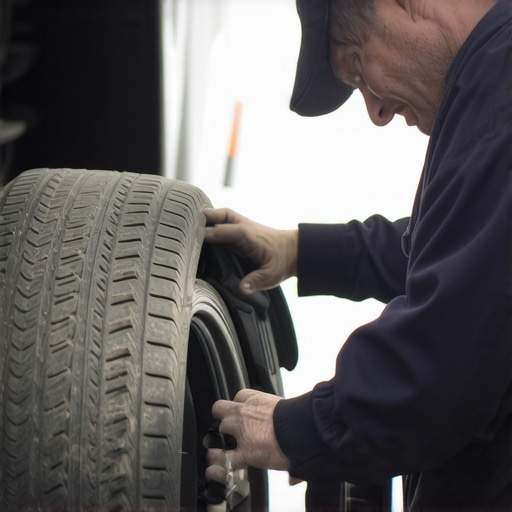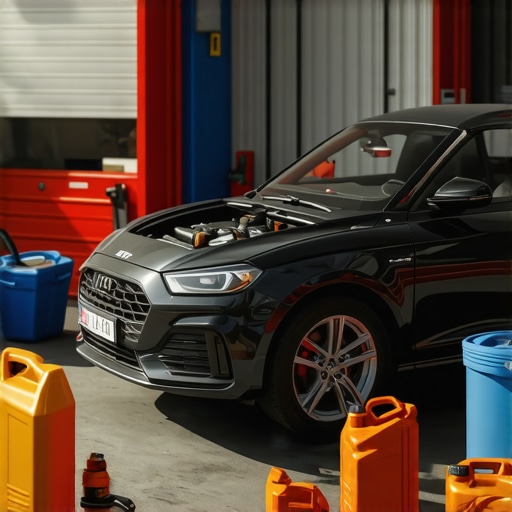Getting Started: How a Simple Oil Change Transformed My Driving Experience
Last year, I found myself stuck in a frustrating situation—my car was running rough, and I realized I hadn’t changed the oil in what felt like ages. That moment sparked my deep dive into understanding how vital regular oil changes and car maintenance are. I decided to share my personal journey and tips to help fellow drivers enjoy a smoother, safer ride in 2024.
Why I Believe Regular Oil Changes Are the Heartbeat of Vehicle Health
From my experience, maintaining the engine’s health begins with simple, consistent oil changes. I learned that fresh oil lubricates engine parts effectively, reducing wear and tear. I now schedule oil changes every 5,000 to 7,500 miles, following my vehicle’s manual recommendations. It’s a small effort that saves me from costly repairs down the line. During my research, I found authoritative advice from Car and Driver emphasizing the importance of quality oil for optimal engine performance.
My Favorite Tools and Tips for a DIY Oil Change
One of my personal milestones was learning how to change my oil at home. I invested in a good oil filter wrench, some high-quality motor oil, and a funnel. The process became surprisingly straightforward, and I felt empowered by doing it myself. I always make sure to dispose of used oil responsibly at local recycling centers. If you’re unsure, check out my recommended guide on Auto Services’ oil change tips for a step-by-step walkthrough.
How Do I Know When It’s Time for an Oil Change?
This question has always intrigued me. Besides mileage, I pay attention to the oil’s color and consistency—if it looks dark and gritty, it’s time for a change. My car’s manual also suggests monitoring oil life indicators. Honestly, I’ve found that listening to my car’s performance—like strange noises or reduced acceleration—alerts me to potential issues. Regular check-ups have made me more confident on the road.
What other car maintenance routines should I prioritize beyond oil changes?
Great question! Besides oil, I focus on brake inspections, tire rotations, and fluid levels. I discovered that a well-maintained brake system is crucial for safety, which is why I regularly visit my trusted brake service provider. It’s all about creating a maintenance routine that keeps my vehicle reliable and safe.
If you’re like me, sharing your experiences and tips can make all the difference. Feel free to comment below or explore more at this helpful resource. Here’s to a smoother, safer ride in 2024!
Unlocking the Full Potential of Your Vehicle: Beyond Basic Oil Changes
While regular oil changes are fundamental to keeping your engine running smoothly, seasoned car enthusiasts and automotive experts recognize that a holistic maintenance routine encompasses several other critical components. These routines not only extend your vehicle’s lifespan but also enhance safety and driving comfort, especially as we navigate the diverse driving conditions of 2024.
How Critical Are Brake System Inspections in Daily Driving?
One area often overlooked until a problem arises is the braking system. Regular brake inspections are essential, as worn brake pads or compromised rotors can significantly impair stopping distance and overall safety. I make it a point to schedule brake checks at least twice a year, particularly before long trips or seasonal changes. For comprehensive insights, my trusted brake service provider emphasizes that proactive brake maintenance can prevent accidents. During inspections, technicians look for uneven pad wear, fluid leaks, and corrosion, which can be subtle yet dangerous if ignored.
What signs indicate my tires need urgent attention?
Proper tire maintenance is equally vital. Uneven tread wear, frequent loss of air pressure, or a visible sidewall crack are clear indicators that your tires require immediate attention. Regular rotation and alignment not only improve handling but also prevent premature tire replacement costs. I recommend checking tire pressure monthly and inspecting for embedded objects or bulges, especially after rough roads. For more detailed guidance, see my article on tire care tips.
Fluid Levels and Their Impact on Vehicle Reliability
Beyond oil, other fluids—coolant, transmission, brake, and power steering—play crucial roles in vehicle performance. Maintaining proper fluid levels prevents overheating, transmission slipping, or steering issues. I keep an eye on fluid color and consistency; dark, gritty, or foamy fluids signal the need for a flush or refill. Regularly scheduled fluid changes, as recommended by my vehicle’s manual, can avoid costly repairs down the road. For a comprehensive approach, check out auto service expert advice.

Image showing a professional vehicle inspection, focusing on brake, tire, and fluid checks, illustrating comprehensive maintenance routines.
How Can I Build a Personalized Maintenance Schedule?
Every vehicle has unique needs based on make, model, and driving habits. I recommend creating a personalized maintenance calendar that aligns with your driving frequency and environmental conditions. Setting reminders for routine checks—like replacing filters, inspecting belts, and testing lights—can save time and money. Consulting your vehicle’s manual provides essential intervals for each maintenance task. Additionally, leveraging credible resources such as Cars.com can help tailor your schedule to specific vehicle requirements and driving environments.
Do you have a go-to maintenance checklist or tips that keep your vehicle performing at its best? Share your experiences in the comments or explore more expert advice to keep your ride safe and reliable for years to come!
Balancing Routine Checks with Unexpected Challenges: My Personal Approach
Over the years, I’ve come to realize that maintaining a vehicle isn’t just about ticking off routine tasks; it’s about cultivating a mindset of proactive awareness. For instance, a few months ago, I noticed my steering felt a bit off, but I couldn’t immediately pinpoint the cause. Instead of waiting for a warning light, I scheduled a comprehensive inspection, which revealed early signs of power steering fluid leakage. That experience taught me the importance of listening to subtle changes and addressing them before they escalate. This nuanced approach has saved me significant time and money, and I encourage fellow drivers to develop their own sensory awareness for vehicle health.
How Do I Tackle the Complexity of Modern Vehicles?
Modern cars are incredibly sophisticated, equipped with advanced sensors and computerized systems that monitor almost every aspect of performance. This complexity can be both a blessing and a challenge. I remember feeling overwhelmed by the array of warning lights and diagnostic codes at first. However, I found that investing in a good OBD-II scanner and learning how to interpret basic codes empowered me. For example, when my vehicle flagged a “misfire,” I initially feared costly repairs. But after some research, I learned it could simply be a spark plug issue—something I could address myself or discuss confidently with my mechanic. This experience underscored the value of understanding the tech behind our vehicles, which is increasingly vital in 2024.
What Advanced Maintenance Practices Should I Incorporate?
Beyond the basics, I started exploring more advanced maintenance routines, such as checking and replacing transmission fluid at recommended intervals—something often overlooked but critical for smooth gear shifts and longevity. According to Cars.com, transmission issues can be costly if neglected. I also pay close attention to the condition of my serpentine belts and hoses, inspecting for cracks or wear that could lead to breakdowns. These proactive steps require a bit more effort, but they’re worth it for the peace of mind and vehicle reliability they provide. I encourage fellow enthusiasts to dive into their vehicle manuals and resources to tailor these advanced checks to their specific models.
Integrating Technology for Smarter Maintenance
One thing that has revolutionized my approach is integrating smartphone apps that track maintenance schedules, log repairs, and send reminders. Using these tools, I maintain a detailed history of all services, which is invaluable when selling or leasing a vehicle, as well as for warranty claims. Additionally, I utilize online forums and manufacturer websites for updates on recalls or technical service bulletins. This digital integration not only streamlines my maintenance routine but also keeps me informed about emerging issues and solutions. If you’re curious about setting up your own system, explore trusted apps and online communities tailored to your vehicle make and model.
Sharing Personal Insights and Inviting Your Experiences
Throughout my journey, I’ve learned that no two vehicles are exactly alike, and what works for me might need adaptation for someone else. That’s why I love engaging with fellow drivers—sharing stories, tips, and lessons learned along the way. If you’ve developed your own advanced maintenance routines or discovered clever tech solutions, I invite you to share in the comments below or reach out through my blog. Your insights could inspire others to elevate their vehicle care in 2024 and beyond. Remember, a well-maintained vehicle is not just about safety and reliability—it’s about respecting the machine that takes us on our journeys every day.
How Can I Detect Hidden Engine Issues Before They Escalate?
Over the years, I’ve learned that proactive diagnostics are crucial in maintaining a vehicle’s longevity. While obvious signs like warning lights are helpful, subtle indicators such as slight vibrations or unexplained odors often signal underlying problems. Investing in a high-quality OBD-II scanner can reveal diagnostic trouble codes early, allowing me to address issues like misfires or sensor malfunctions before they cause significant damage. Regularly analyzing these codes, combined with routine visual inspections, creates a layered defense that keeps my engine running smoothly. According to a recent article by Cars.com, early detection through advanced diagnostics can save hundreds, if not thousands, in repair costs by catching problems at their inception.
What Are My Best Practices for Optimizing Fuel Efficiency Through Maintenance?
Optimizing fuel efficiency isn’t solely about driving habits; it hinges on meticulous maintenance routines. I prioritize checking and replacing air filters regularly, as clogged filters reduce engine performance. Ensuring spark plugs are in prime condition also contributes to complete combustion, which directly impacts mileage. Additionally, maintaining proper tire pressure and alignment minimizes rolling resistance, further enhancing efficiency. For instance, I use a digital tire pressure gauge monthly to avoid the common mistake of under-inflation. Incorporating fuel system cleaning at recommended intervals, as suggested by auto industry experts, can also prevent clogging, ensuring optimal fuel atomization. These practices collectively save money and reduce environmental impact, making my vehicle greener and more economical.
How Do I Incorporate Preventive Maintenance for Hybrid and Electric Vehicles?
Living with a hybrid or electric vehicle requires adapting traditional maintenance routines with a focus on specific components. For hybrid cars, I pay close attention to battery health, ensuring it receives proper cooling and avoiding deep discharges. Regularly inspecting high-voltage cables and connectors for wear or damage is critical, as these can pose safety risks. Although electric vehicles have fewer moving parts, maintaining the coolant systems for batteries and motors is vital—neglecting this can lead to overheating and reduced lifespan. I also monitor software updates from manufacturers, as they often include performance improvements and bug fixes that enhance longevity. Consulting authoritative sources like Cars.com emphasizes that proactive care tailored to EV components is essential for maximizing investment and ensuring safety in 2024.
What Advanced Techniques Can I Use for Extending My Vehicle’s Battery Life?
Extending battery life is a top priority for electric vehicle owners. I make it a point to avoid frequent deep discharges and instead keep the battery charge within an optimal range—generally between 20% and 80%. Using a smart charger that regulates charge rates prevents overheating during charging cycles. Additionally, I avoid exposing the battery to extreme temperatures by parking in shaded or climate-controlled environments whenever possible. Regularly updating the vehicle’s firmware ensures the battery management system operates efficiently, as per the insights from automotive technology reports. Moreover, I plan my trips to minimize rapid acceleration and high-speed driving, which can accelerate battery degradation. These nuanced strategies help me get the most out of my EV’s battery, ensuring reliability and extending its lifespan well beyond the typical warranty period.
How Can I Leverage Technology and Data for Smarter Maintenance Decisions?
Embracing digital tools has revolutionized my approach to vehicle care. I utilize dedicated maintenance apps that sync with my car’s onboard diagnostics, providing real-time data and predictive alerts for upcoming service needs. These platforms can track oil life, tire health, and fluid levels, offering personalized reminders based on my driving patterns. I also subscribe to manufacturer recall notifications and technical bulletins through official portals, ensuring I stay ahead of potential issues. This integration of technology not only streamlines my maintenance routine but also empowers me with actionable insights. For enthusiasts eager to optimize their vehicle upkeep, exploring reputable maintenance apps and online communities can provide invaluable support and shared experiences. The goal is to turn routine checks into data-driven decisions that enhance safety, reliability, and vehicle performance in 2024 and beyond.
Feel free to share your advanced maintenance practices or ask questions about specific vehicle systems. Together, we can elevate our car care game and ensure our vehicles serve us reliably for many miles to come.
Things I Wish I Knew Earlier (or You Might Find Surprising)
The Hidden Power of Regular Maintenance
Looking back, I realize that sticking to a consistent maintenance routine transformed my driving experience more than I ever expected. Small habits like checking fluid levels or inspecting tires might seem trivial, but they can prevent major headaches down the road. I used to ignore subtle signs of wear, only to regret it later when costly repairs were needed. Now, I see maintenance as a form of respect for my vehicle and my safety.
The Myth of the “Perfect Time” for Oil Changes
I used to think I needed to follow a strict mileage or time schedule, but I’ve learned that listening to my car’s signals and considering driving conditions is just as important. Dark, gritty oil or strange engine noises are clear indicators that it’s time for a change—much more reliable than just mileage alone. This approach has saved me from unnecessary oil changes and extended the life of my engine.
DIY Oil Changes: Empowerment and Responsibility
Changing my own oil was a game-changer. It made me feel more connected to my vehicle and saved money. The key is using quality tools, like a good oil filter wrench, and disposing of used oil responsibly. Plus, I found that following detailed guides, like the ones from auto service experts, made the process straightforward and even fun. It’s a skill I highly recommend every driver learn.
Monitoring Subtle Signs of Vehicle Trouble
Over the years, I’ve become more attuned to my car’s subtle cues—strange vibrations, weird smells, or slight steering issues. These small signals often hint at bigger problems that can be prevented with early intervention. Regular inspections and diagnostic tools like an OBD-II scanner help me catch issues before they escalate, saving time and money.
Beyond Oil: Embracing a Holistic Approach
While oil changes are fundamental, I’ve found that a holistic maintenance routine—covering brakes, tires, fluids, and even advanced features—keeps my vehicle running smoothly. For instance, proactive brake inspections and tire rotations have prevented emergencies. Using digital maintenance apps helps me stay organized and ensures nothing slips through the cracks as I customize my schedule based on my driving habits.
Resources I’ve Come to Trust Over Time
- Car and Driver: Their thorough reviews and expert articles deepen my understanding of vehicle performance and maintenance. I recommend it to anyone wanting an authoritative resource.
- Auto Services’ Guide on Oil Changes: Clear, step-by-step instructions that made DIY oil changes accessible and stress-free for me. It’s a must-visit for beginners.
- Cars.com: Their comprehensive articles on car care routines and troubleshooting have been invaluable in guiding my maintenance decisions.
Parting Thoughts from My Perspective
Maintaining a vehicle in 2024 is about more than just routine checks; it’s about cultivating awareness and embracing technology that empowers us. Regular oil changes, when combined with a holistic approach, can significantly extend your car’s lifespan, improve safety, and even save money. My best advice is to listen to your car, stay informed with trusted resources, and don’t be afraid to get your hands dirty—learning a few DIY tricks can be incredibly rewarding. If this resonates with you, I’d love to hear your thoughts or experiences. Feel free to share in the comments or pass this along to a fellow driver looking to optimize their car care routine in 2024.”}

